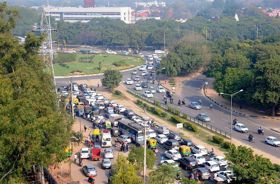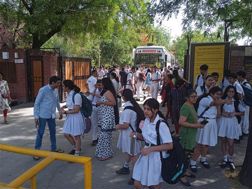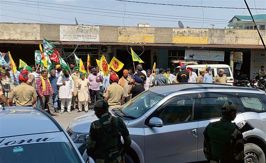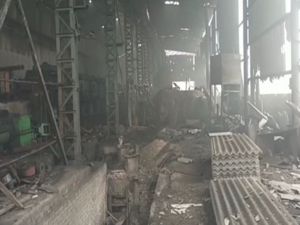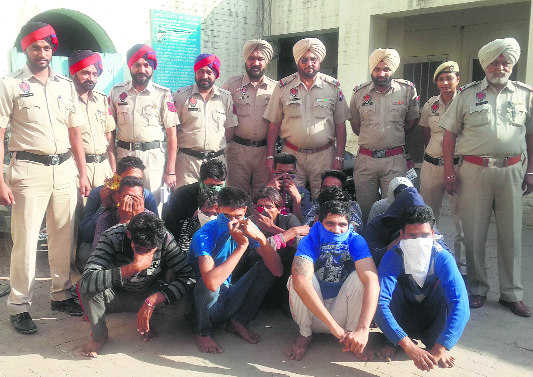
Far away from the border, heroin and synthetic drugs are compelling its users into crime, penury and irreversible ill-health.
Sandeep Dikshit in New Delhi
The mindboggling seizure of heroin at the Attari Integrated Check Post (ICP) must not be treated as yet another case of smugglers running out of luck on the Indo-Pak border. The links stretched from Afghanistan, via active Pakistani connivance, to Handwara in Kashmir. Handwara had popped up in another seizure last year too; 51 kg of heroin from Afghanistan was being transported to Punjab.
Read also:
In case of militancy in Kashmir, the crackdown on financiers of the violence may have led to a greater dependence on drugs as replenishment for the dried up channels of funding. But as these drugs travel through or are consumed in rest of India, its national security implications are much broader. The weakening of human fibre by these habit-forming opiates is as much a national security headache as the purchase of guns, bombs and loyalty in Kashmir.
Far away from the border, heroin and synthetic drugs are compelling its users into crime, penury and irreversible ill-health. Ill-gotten funds contribute to money laundering, thus destabilising the national economy. India’s national average of HIV infection among injecting drugs users is stated to be several times higher than in other countries.
But it will be shortsighted to view the regular haul of “hard drugs” on the Indo-Pak border only as a conspiracy to weaken the Indian social fabric by enticing youngsters into their consumption. There are three major global centers of heroin and cocaine processing that target the two 19 trillion economies of US and EU (India is barely a 3 trillion dollar economy). India is the transit route of two of these three centers – the “Golden Triangle” of Myanmar, Thailand and Laos and the “Golden Crescent”of Afghanistan, Iran and Pakistan. The third is South America whose pushers have no need to push cocaine through India.
This aspect was brought out in the UN World Drug Report 2014, which reported that of the total heroin seized in India, Southwest Asian origin was 45 per cent while the rest originated in India. This view gained credence after the seizure in Delhi of nearly 10 tonnes of acetic anhydride that is used to process opium into heroin. The heroin from Southwest Asia that reaches India is generally smuggled to Europe and the US, the report concluded.
The size of the Attrai ICP seizure — about half a tonne — compares with similar confiscations in Europe, leading Indian intelligence to suspect it was meant for a European or American destination. Germany had uncovered 670 kg last year in a truck coming from Poland while Ukraine's intelligence agency seized 500 kg from a luxury car in Kiev. These hauls are dwarf in comparison to the seizures at the fountainhead of cocaine processing in South America where recoveries of 2,000 kg are routine.
Law enforcement officials can claim that smugglers were trying to push the drug through an alternate route because the Indo-Pak border is near-impregnable. But before this 539-kg haul, annual seizures on the Punjab side of the Indo-Pak border have averaged 250-odd kg.
When compared with the seizures in Europe and the US, or even in Peru and Brazil where the Americans have helped with vastly improved detection and surveillance techniques, Indian hauls of contraband are puny in size. For instance, a two-year multi-country operation against the Italian mafia group ‘Ndrangheta’ ended with the seizure of 4,000 kg of cocaine. Germany routinely uncovers 6,000 kg of hard drugs every year. This raises the question whether the Indian investigators lack capacity — both human and technical — to detect larger quantities of drugs than they have done so far.
The heroin smuggled from Pakistan has had an immediate fall-out in the border districts of Punjab — Tarn Taran has the highest number of known drug users in rural areas while Amritsar tops among the state’s urban areas. Fortunately, NDPS cases registered in Punjab districts away from the border are more for possession or trade in locally smuggled opium, poppy husk and hashish besides pharmaceutical drugs. But that could change as India’s youthful population experiences rising disposable incomes while producers in Afghanistan and their abettors in Pakistan keeps attempting to find new transit points for pushing heroin.
India is an alternate for the southern route which travels through Iran and Turkey. Afghanistan’s heroin also has a northern route that courses through Central Asia and Russia to Europe. The networks rose in the mid-80s when the Afghan government lost territory to the Mujahidin and production of opium soared from 140 tonnes in 1984 to 400 tonnes, all with the knowledge of the CIA and the ISI. A devastated Afghanistan has both the lowest troop to people ratio and the lowest international aid to population ratio in a conflict zone. It can hardly take on the drug networks that have become too powerful and strong to be dismantled while Afghanistan remains in disarray.
India’s hopes for averting a hard drugs epidemic lie in a turnaround of its drug detection abilities as well as a hard look at its present narcotics policy in view of the acceptance of soft drugs in several countries around the world.
A more liberal narcotics policy will free the security agencies from the drudgery (or the temptation) of chasing small-time suppliers of cheap marijuana and hashish and leave them to focus on habit-forming hard drugs such as heroin and synthetic drugs such as tramadol and methamphetamine, which are leaving a trail of devastation in several pockets of urban India and large parts of the countryside in the Northeast. After all, there have been no instances of Pakistani smugglers trying to smuggle a truck load of marijuana worth a few lakhs of rupees or of the Taliban financing their war with hashish smuggling. The cause of national security will be better served by prioritising the neutralisation of chemical and hard drugs’ networks by a better-equipped force.






















